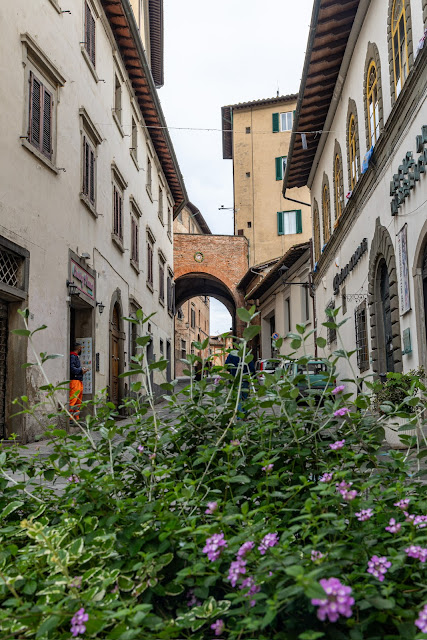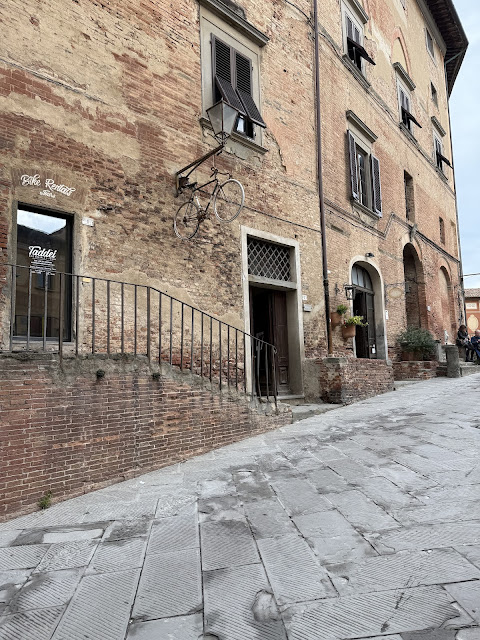Snapshots from Italy...
Part 1
 |
| Leaning tower of Pisa and Pisa Cathedral |
When you think of Italy and all the famous sites, Leaning Tower of Pisa is right up there with the Gondola rides in Venice, the Colosseum in Rome, and the Sistine Chapel in Vatican City among so many others. We have been to Italy previously, spending time in Venice, Florence and Rome, so we decided not to go into those cities at all on this trip, as we also factored in the time is would take to get from the ports to the center of these great cities. For our cruise, our port city for Florence was Livorno, and for Rome it was Civitavecchia. It was a 1.5-2 hours drive into Florence and Rome from the ports we docked in. In addition, cruise ships are no longer allowed to dock in the city of Venice, so they have to dock in alternate ports and take water taxis into the city. The various replacement ports now take from 45 minutes to 3 hours in a water taxi to get into Venice.
Important cruise Tip...If you are going on a mediterranean cruise, make sure you know at which ports your ship will be docking so there are no surprises when you arrive.
Pisa
We were docked in Livorno for two nights, so we decided to go to see the leaning tower of Pisa instead of Florence. It was really cool to see this in person, but it was very crowded! The leaning tower of Pisa (the bell tower) stands in the Piazza del Duomo in the city of Pisa. Also present within the Piazza del Duomo are the Pisa Cathedral, the baptistery and the cemetery. These monuments were all built between the 11th - 14th centuries.
 |
| Piazza del Duomo |
 |
| Leaning tower of Pisa (the bell tower) |
The leaning tower of Pisa was build on soft soil that allowed the foundation to settle unevenly resulting in the tower leaning. In 1990, the lean had reached 5.5 degrees and there were growing concerns that the tower would topple. Shortly thereafter, significant remediation was performed on the bell tower to stabilize the structure to the current 3.99 degrees. The tower is once again open for tourists to climb to the top.
 |
| View of the cathedral and the bell tower through an upper window of the baptistery. |
 |
| Interior of the cathedral |
 |
| Altar of the cathedral |
 |
Ceiling of the cathedral
|
 |
| Baptsistery |
 |
| Baptistery from a different angle to show the two different types of roof tiles. |
The first floor of the baptistry was build in the romanesque architectural style in the 11th century and the remainder of the monument was built in the gothic style. If you look, the roof tiles on the baptistry are different from one side to the other. It turns out, they ran out of money while building the baptistry so they had to change roof materials in order to finish the roof. This is one reason roof tiles are different colors with both gray and red roof tiles. (In the lower photo above, it looks like the baptistry is leaning a bit. That is not the case, it is a novice photographer error - I didn't hold my camera level.)
 |
| Interior of the baptistry |
We did not spend much time in the cemetery as time was short, but it was nice as well with a pretty green space central area. It was the least well preserved of the monuments, though.
 |
| Cemetery |
 |
| Cemetery frescos |
Tuscany
We spent the rest of our time in Livorno in Tuscany. We had never been to this region before and it did not disappoint even though it was rainy and cloudy during our time there. Tuscany and its countryside are filled with rolling hills with rows upon rows of grape vines. It is a prime wine growing region, as well as, producer of extra virgin olive oil. We were able to visit two craft wineries and a couple of charming villages while we were there.
 |
Village of San Miniato
|
 |
Village of San Miniato
Countryside overlook from San Miniato |
 |
Village of San Miniato - I love the bike on the side of the building!
| Olive tree.
We visited Tuscany at the end of October. Most of the grapes had already been harvested for wine, but it was the season for olives to be harvested for olive oil. The wineries we visited were all in the process of harvesting and processing their olives into extra virgin olive oil. The olives need to be processed within 24 hours of picking along with other regulations to have the name extra virgin olive oil.
 | | Countryside of the Village of Vinci |
We visited a lovely winery for dinner in the village of Vinci. The famous painter Leonardo da Vinci is said to have been born in or near the village of Vinci. The winery was called Dianella winery. It was a lovely place where you can come to buy and taste their wine and they also hosted weddings and other events.
|
The next morning we headed to the village of San Gimignano. Then we visited Fattoria San Donato a lovely farm and vineyard just outside the village. The photos below are from the village of San Gimignano.
|

Tarquinia
After Livorno/Florence, we headed south to Civitavecchia (Rome). As we had already visited Rome and there was a 2 hour bus ride into the City, we opted to see Etruscan Ruins in Tarquinia.
- Snapshots of Italy, Part 2
- Croatia
@vikingcruises



































Comments
Post a Comment